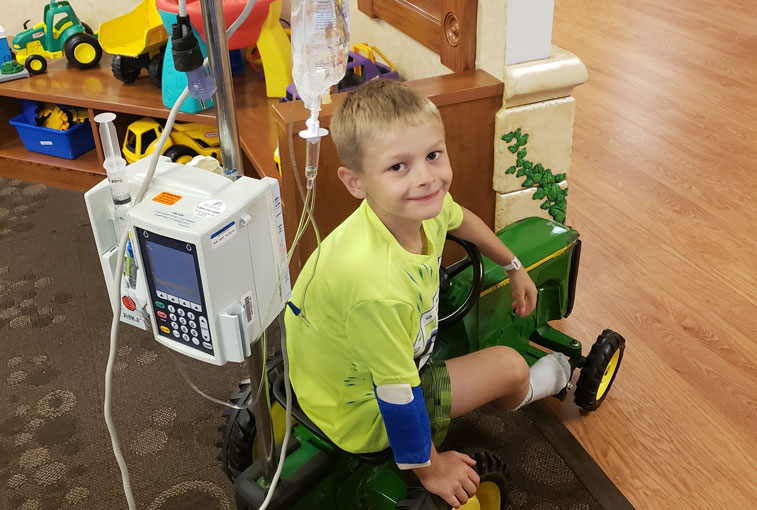Carson Gietzen, 7, has spent much of his short life in and out of the hospital, battling an immune deficiency.
When Carson was 2 weeks old, he started getting infections. Since then, he’s been diagnosed with a long list of medical conditions including chronic lung disease and adrenal insufficiency.
In the past year, Carson’s health has improved substantially. He has started undergoing intravenous immunoglobulin (IVIG) therapy at Sanford Children’s in Bismarck, North Dakota. This helps his body fight off infection.
“It’s been life-changing,” said Carson’s mother, Rachel. “He hasn’t had to be hospitalized with an infection for a year.”
Every three weeks, Carson takes a day off from first grade to receive treatments at the children’s hospital. He spends most of the time watching movies, playing video games and resting. However, he first needs to have an IV inserted for his treatment to be administered.
Until recently, Carson’s anxiety around these IV starts made the process painful for everyone involved.
Then, Sanford Bismarck launched western North Dakota’s first child life program. The team members — Ashley Renton, a certified child life specialist, and Bobbi Jo Vandal, a board-certified music therapist — started using distraction and coping techniques to help Carson during his IV starts.
Today, Carson’s experience has improved substantially. During his treatment, he composes songs based on his favorite video game, Fortnite, or wears a virtual reality headset to keep his mind off the needle.
Music therapists use instrument play, singing, improvisation, songwriting, movement, lyric analysis, even music video creation to address patients’ needs. For example, music therapists can help by:
- Improving a child’s self-expression
- Supporting speech, physical and developmental goals
- Supporting coping skills and emotional processing
- Assisting with pain management, relaxation and procedure support
Also a part of the care team, a child life specialist helps to make the hospital a less scary place and allows kids to still be kids. They can use activities to distract during a procedure, prepare kids for an upcoming treatment through medical play, and educate them on a diagnosis in language kids can understand.
“They have really learned to connect with him,” Rachel said. “They worked with us to give the best care for him. They just try to make him feel special.”
Learn more about Sanford Children’s.
More stories
- Child life program launches in Bismarck
- Child life specialists provide invaluable help to families
- Music therapy a calling for Sanford Health’s Anna Mitchell
…
Posted In Bismarck, Children's, Foundation, News

